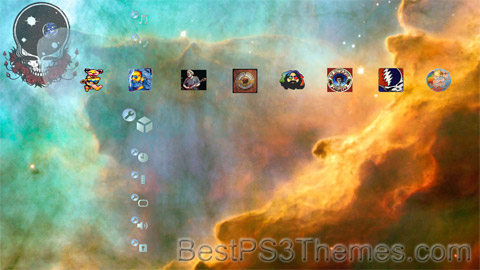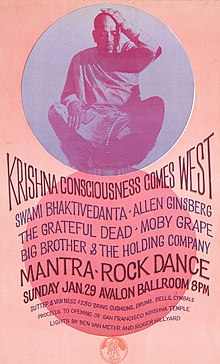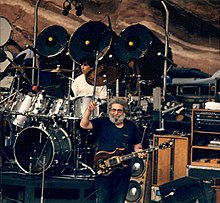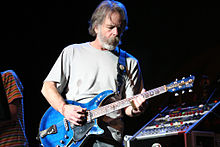Grateful Dead theme by Jay Brune
Download: GratefulDead.p3t

(1 background)
Grateful Dead | |
|---|---|
 A promotional photo of Grateful Dead in 1970. Left to right: Bill Kreutzmann, Ron McKernan, Jerry Garcia, Bob Weir, Mickey Hart, and Phil Lesh. | |
| Background information | |
| Also known as | The Warlocks |
| Origin | Palo Alto, California, U.S. |
| Genres | Rock |
| Discography | Grateful Dead discography |
| Years active | 1965–1995 |
| Labels | |
| Spinoffs |
|
| Past members | |
| Website | dead |
The Grateful Dead were an American rock band formed in 1965 in Palo Alto, California,[1][2] known for their eclectic style that fused elements of rock, blues, jazz, folk, country, bluegrass, rock and roll, gospel, reggae, and world music with psychedelia.[3][4] The band is famous for improvisation during their live performances,[5][6] and attracted a devoted fan base, known as "Deadheads." According to the musician and writer Lenny Kaye, the music of the Grateful Dead "touches on ground that most other groups don't even know exists."[7] For the range of their influences and the structure of their live performances, the Grateful Dead are considered "the pioneering godfathers of the jam band world".[8]
The Grateful Dead were founded in the San Francisco Bay Area during the rise of the counterculture of the 1960s.[9][10][11][12] The band's founding members were Jerry Garcia (lead guitar and vocals), Bob Weir (rhythm guitar and vocals), Ron "Pigpen" McKernan (keyboards, harmonica, and vocals), Phil Lesh (bass guitar and vocals), and Bill Kreutzmann (drums).[13] Members of the Grateful Dead, originally known as the Warlocks, had played together in various Bay Area ensembles, including the traditional jug band Mother McCree's Uptown Jug Champions. Lesh was the last member to join the Warlocks before they changed their name to Grateful Dead, replacing Dana Morgan Jr., who had played bass for a few gigs. Drummer Mickey Hart and non-performing lyricist Robert Hunter joined in 1967. With the exception of McKernan, who died in 1973, and Hart, who left the band from 1971 to 1974, the core of the band stayed together for its entire 30-year history.[14] Other official members of the band included Tom Constanten (keyboards from 1968 to 1970), John Perry Barlow (non-performing lyricist from 1971 to 1995),[15] Keith Godchaux (keyboards and occasional vocals from 1971 to 1979), Donna Godchaux (vocals from 1972 to 1979), Brent Mydland (keyboards and vocals from 1979 to 1990), and Vince Welnick (keyboards and vocals from 1990 to 1995).[16] Bruce Hornsby (accordion, piano, vocals) was a touring member from 1990 to 1992, as well as a guest with the band on occasion before and after the tours.
After Garcia's death in 1995, former members of the band, along with other musicians, toured as The Other Ones in 1998, 2000, and 2002, and as The Dead in 2003, 2004, and 2009. In 2015, the four surviving core members marked the band's 50th anniversary in a series of concerts in Santa Clara, Calif. and Chicago that were billed as their last performances together.[17] There have also been several spin-offs featuring one or more core members, such as Dead & Company, Furthur, the Rhythm Devils, Phil Lesh and Friends, RatDog, and Billy & the Kids.
Despite having only one top-40 single in their 30-year career, "Touch of Grey," the Grateful Dead remained among the highest-grossing American touring acts for decades. They gained a committed fanbase by word of mouth and through the free exchange of their live recordings, encouraged by the band's allowance of taping. In 2024, they broke the record for most top-40 albums on the Billboard 200 chart.[18] Rolling Stone named the Grateful Dead number 57 on its 2011 list of the "100 Greatest Artists of all Time".[19] The band was inducted into the Rock and Roll Hall of Fame in 1994,[20] and a recording of their May 8, 1977 performance at Cornell University's Barton Hall was added to the National Recording Registry of the Library of Congress in 2012.[21]
Formation (1965–1966)[edit]

The Grateful Dead began their career as the Warlocks, a group formed in early 1965 from the remnants of a Palo Alto, California jug band called Mother McCree's Uptown Jug Champions and members of The Wildwood Boys (Jerry Garcia, Ron "Pigpen" McKernan, David Nelson, Robert Hunter, and Norm Van Maastricht).[22] As The Wildwood Boys they played regularly at The Tangent, a folk music coffeehouse operated by Stanford Medical Center doctors Stuart "Stu" Goldstein and David "Dave" Shoenstadt on University Avenue in Palo Alto (1963).[23] As the Warlocks, the band's first show was at Magoo's Pizza Parlor, at 639 Santa Cruz Avenue in suburban Menlo Park, on May 5, 1965, now a Harvest furniture store. It continued playing bar shows,[24] like Frenchy's Bikini-A-Go-Go[25][26] in Hayward and, importantly, five sets a night, five nights a week, for six weeks, at the In Room[27][28] in Belmont as the Warlocks,[29] but quickly changed the band's name after finding out that a different band known as the Warlocks had put out a record under that name. (The Velvet Underground also had to change its name from the Warlocks.)[30]
The first show under the name Grateful Dead was in San Jose on December 4, 1965, at one of Ken Kesey's Acid Tests.[31][32][33] Scholar Michael Kaler has written that the Dead's participation in the Acid Tests was crucial both to the development of their improvisational vocabulary and to their bonding as a band, with the group having set out to foster an intra-band musical telepathy.[34] Kaler has further pointed out that the Dead's pursuit of a new improvisatory rock language in 1965 chronologically coincided with that same goal's adoption by Jefferson Airplane, Pink Floyd and the Velvet Underground.[35]
Earlier demo tapes have survived, but the first of over 2,000 concerts known to have been recorded by the band's fans was a show at the Fillmore Auditorium in San Francisco on January 8, 1966.[36] Later that month, the Grateful Dead played at the Trips Festival, a three-day psychedelic rock weekend party and event produced by Ken Kesey, Stewart Brand, and Ramon Sender, that, in conjunction with the Merry Pranksters, brought the nascent hippie movement together for the first time.[37][38]
The name "Grateful Dead" was chosen from a dictionary. According to Lesh, Garcia "picked up an old Britannica World Language Dictionary ... [and] ... In that silvery elf-voice he said to me, 'Hey, man, how about the Grateful Dead?'"[39] The definition there was "the soul of a dead person, or his angel, showing gratitude to someone who, as an act of charity, arranged their burial." According to Alan Trist, director of the Grateful Dead's music publisher company Ice Nine, Garcia found the name in the Funk & Wagnalls Folklore Dictionary, when his finger landed on that phrase while playing a game of Fictionary.[40] In the Garcia biography Captain Trips, author Sandy Troy states that the band was smoking the psychedelic DMT at the time.[41] The term "grateful dead" appears in folktales from a variety of cultures.[42]
Other supporting personnel who joined early included Rock Scully, who heard of the band from Kesey and signed on as manager after meeting them at the Big Beat Acid Test; Stewart Brand, "with his side show of taped music and slides of Indian life, a multimedia presentation" at the Big Beat and then, expanded, at the Trips Festival; and Owsley Stanley, the "Acid King" whose LSD supplied the Acid Tests and who, in early 1966, became the band's financial backer, renting them a house on the fringes of Watts, Los Angeles, and buying them sound equipment. "We were living solely off of Owsley's good graces at that time. ... [His] trip was he wanted to design equipment for us, and we were going to have to be in sort of a lab situation for him to do it", said Garcia.[41]
Main career (1967–1995)[edit]
Pigpen era (1967–1972)[edit]

One of the group's earliest major performances in 1967 was the Mantra-Rock Dance, a musical event held on January 29, 1967, at the Avalon Ballroom by the San Francisco Hare Krishna temple. The Grateful Dead performed at the event along with the Hare Krishna founder Bhaktivedanta Swami, poet Allen Ginsberg, bands Moby Grape and Big Brother and the Holding Company with Janis Joplin, donating proceeds to the temple.[43][44] The band's first LP, The Grateful Dead, was released on Warner Brothers in 1967.
On May 3, 1968, the band played a free concert at Columbia University during the anti–Vietnam War student protests during which students occupied several campus buildings. In order to play, the band, equipment and all, had to be “smuggled” on campus in the back of a bread delivery truck. “We were already jamming away before the security and police could stop us.”[45]
Classically trained trumpeter Phil Lesh performed on bass guitar. Bob Weir, the youngest original member of the group, played rhythm guitar. Ron "Pigpen" McKernan played keyboards, percussion, and harmonica until shortly before his death in 1973 at the age of 27. Garcia, Weir, and McKernan shared the lead vocal duties more or less equally; Lesh sang only a few leads, but his tenor was a key part of the band's three-part vocal harmonies. Bill Kreutzmann played drums, and in September 1967 was joined by a second drummer, New York City native Mickey Hart, who also played a wide variety of other percussion instruments.
1970 included tour dates in New Orleans, where the band performed at The Warehouse for two nights. On January 31, 1970, the local police raided their hotel on Bourbon Street and arrested and charged 19 people with possession of various drugs.[46] The second night's concert was performed as scheduled after bail was posted. Eventually, the charges were dismissed, except those against sound engineer Owsley Stanley, who was already facing charges in California for manufacturing LSD. This event was later memorialized in the lyrics of “Truckin'", a single from American Beauty that reached number 64 on the charts.
Hart took time off from the band in February 1971, after his father, an accountant, absconded with much of the band's money;[47] Kreutzmann was once again as the sole percussionist. Hart rejoined the Grateful Dead for good in October 1974. Tom "TC" Constanten was added as a second keyboardist from 1968 to 1970, to help Pigpen keep up with an increasingly psychedelic sound, while Pigpen transitioned into playing various percussion instruments and vocals.
After Constanten's departure, Pigpen reclaimed his position as sole keyboardist. Less than two years later, in late 1971, Pigpen was joined by another keyboardist, Keith Godchaux, who played grand piano alongside Pigpen's Hammond B-3 organ. In early 1972, Keith's wife, Donna Jean Godchaux, joined the Grateful Dead as a backing vocalist.
Following the Grateful Dead's "Europe '72" tour, Pigpen's health had deteriorated to the point that he could no longer tour with the band. His final concert appearance was June 17, 1972, at the Hollywood Bowl, in Los Angeles;[48][49] he died on March 8, 1973, of complications from liver damage.[50]
Godchaux era (1972–1979)[edit]
Pigpen's death did not slow down the Grateful Dead. With the help of manager Ron Rakow, the band soon formed its own record label, Grateful Dead Records.[51] Later that year, it released its next studio album, the jazz-influenced Wake of the Flood, which became their biggest commercial success thus far.[52] Meanwhile, capitalizing on the album's success, the band soon went back to the studio, and in June 1974 released another album, From the Mars Hotel. Not long after, the Dead decided to take a hiatus from live touring. The band performed a series of five concerts at the Winterland Ballroom in San Francisco in October 1974, and delved into various other projects.[53] The Winterland concerts were filmed, and Garcia compiled the footage into The Grateful Dead Movie, a feature-length concert film released in 1977.[54]
In September 1975, the Dead released their eighth studio album, Blues for Allah. The band resumed touring in June 1976, playing multiple dates in small theaters, rather than the stadium shows that had become common, and had exhausted them, in 1974.[51] That same year, they signed with Arista Records, and the new contract produced Terrapin Station in July 1977. The band's tour in the spring of that year is held in high regard by its fans, and its concert of May 8 at Cornell University is often considered one of the best performances of its career.[55][56][57] Their September 1977 concert at Raceway Park in Old Bridge Township, New Jersey was attended by 107,019 people and held the record for largest-ticketed concert in the United States by a single act for 47 years.[58]
Keith and Donna Jean Godchaux left the band in February 1979, citing artistic differences.
Mydland/Welnick era (1979–1995)[edit]

Following the Godchauxs' departure, Brent Mydland joined as keyboardist and vocalist and was considered "the perfect fit." The Godchauxs then formed the Heart of Gold Band, before Keith died in a car accident in July 1980. Mydland was the keyboardist for the Grateful Dead for 11 years until his death by narcotics overdose in July 1990,[59] becoming the third keyboardist to die.
Shortly after Mydland found his place in the early 1980s, Garcia's health began to decline. He became a frequent smoker of "Persian," a type of heroin, and he gained weight at a rapid pace. He lost his liveliness on stage, his voice was strained, and Deadheads worried for his health. After he began to curtail his opiate usage gradually in 1985, Garcia slipped into a diabetic coma for several days in July 1986, leading to the cancelation of all concerts in the fall of that year. Garcia recovered, the band released In the Dark in July 1987, which became its best-selling studio album and produced its only top-40 single, "Touch of Grey," Also, that year, the group toured with Bob Dylan, as heard on the album Dylan & the Dead.
Mydland died in July 1990 and Vince Welnick, former keyboardist for the Tubes, joined as a band member, while Bruce Hornsby, who had a successful career with his band the Range, joined temporarily as a bridge to help Welnick learn songs. Both performed on keyboards and vocals—Welnick until the band's end, and Hornsby mainly from 1990 to 1992.
Saxophonist Branford Marsalis played five concerts with the band between 1990 and 1994.[60]
The Grateful Dead performed its final concert on July 9, 1995, at Soldier Field in Chicago.[61]
Aftermath (1995–present)[edit]



Jerry Garcia died on August 9, 1995. A few months after Garcia's death, the remaining members of the Grateful Dead decided to disband.[62] Since that time, there have been a number of reunions by the surviving members involving various combinations of musicians. Additionally, the former members have also begun or continued individual projects.
In 1998, Bob Weir, Phil Lesh, and Mickey Hart, along with several other musicians, formed a band called the Other Ones, and performed a number of concerts that year, releasing a live album, The Strange Remain, the following year. In 2000, the Other Ones toured again, this time with Kreutzmann but without Lesh. After taking another year off, the band toured again in 2002 with Lesh. That year, the Other Ones then included all four living former Grateful Dead members who had been in the band for most or all of its history. At different times the shifting lineup of the Other Ones also included guitarists Mark Karan, Steve Kimock, and Jimmy Herring, keyboardists Bruce Hornsby, Jeff Chimenti, and Rob Barraco, saxophonist Dave Ellis, drummer John Molo, bassist Alphonso Johnson, and vocalist Susan Tedeschi.[63]
In 2003, the Other Ones, still including Weir, Lesh, Hart, and Kreutzmann, changed their name to the Dead.[64] The Dead toured the United States in 2003, 2004 and 2009. The band's lineups included Jimmy Herring and Warren Haynes on guitar, Jeff Chimenti and Rob Barraco on keyboards, and Joan Osborne on vocals.[65] In 2008, members of the Dead played two concerts, called "Deadheads for Obama" and "Change Rocks".
Following the 2009 Dead tour, Lesh and Weir formed the band Furthur, which debuted in September 2009.[66] Joining Lesh and Weir in Furthur were John Kadlecik (guitar), Jeff Chimenti (keyboards), Joe Russo (drums), Jay Lane (drums), Sunshine Becker (vocals), and Zoe Ellis (vocals). Lane and Ellis left the band in 2010, and vocalist Jeff Pehrson joined later that year. Furthur disbanded in 2014.[67]
In 2010, Hart and Kreutzmann re-formed the Rhythm Devils, and played a summer concert tour.[68]
Since 1995, the former members of the Grateful Dead have also pursued solo music careers. Both Bob Weir & RatDog[
2 Replies to “Grateful Dead”
Comments are closed.

Nice. love it
i love it!